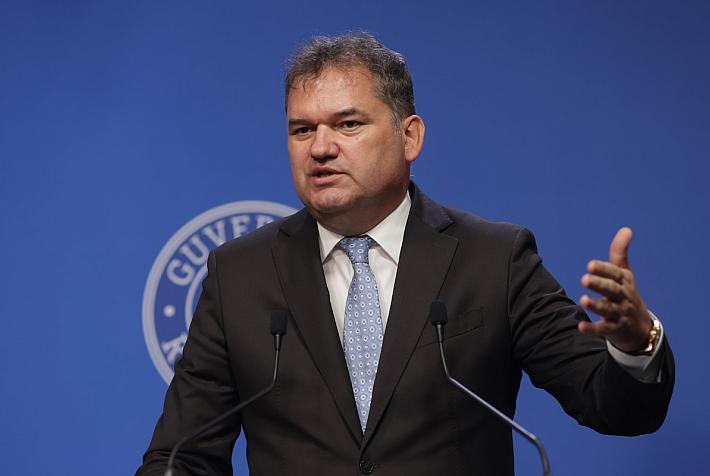Romania’s economy in 2018: growth slows down amid rising imbalances

Romania’s economic growth remained robust in 2018 but decelerated from the record level reached in 2017 as the effect of the tax breaks and wage increases began to fade. The financial sector continued to thrive and banks recorded record profits in the first nine months. Meanwhile, the Government struggled to keep the budget deficit under control and the external imbalances increased, making the economy more vulnerable to shocks.
REAL SECTOR
GDP growth -- decelerating, yet still robust
Romania’s GDP growth rate remained above 4% during each of the first three quarters of 2018, driven by private demand for consumption, but also by the continuing build-up of inventory. Both drivers are not sustainable and the inventory cycle might make a negative impact as soon as the first quarters of 2019. The European Commission expects country’s growth to decelerate below 4% per year in 2019-2020 as the fiscal stimulus fades away and amid broader slowdown in Europe.
Gross fix capital formation made negative contributions in Q2 and Q3, further weakening the sustainability of the growth. The figures still look impressive: GDP increased by a real 4.3% in Q3 of 2018 compared to same quarter in 2017 (y/y), accelerating from 4.2% y/y in Q2 and 4.1% y/y in Q1. The seasonally adjusted GDP edged up by 1.9% in Q3 compared to Q2 (q/q), a significant advance in absolute terms and compared to the 1.5% q/q advance in Q2 and the 0.3% q/q advance in Q1. But the detailed investigations of Q3 GDP by utilization breakdown confirms concerns: households’ consumption contributed 2.8 percentage points (pp) to the overall 4.3% y/y GDP growth in the quarter. Nonetheless, the inventory build-up contributed even more: 3.3pp. Gross fixed capital formation (investments), by contrast, contributed a negative 0.4pp. On the formation side, agriculture contributed 1.2 pp to the overall 4.3% y/y advance in Q3, while industry contributed 1.1pp. The net taxes on products, measuring the volume of taxes raised by the government from companies and households less transfers extended to companies and households, contributed a significant 1pp to the overall GDP growth and this indicates tougher fiscal pressure.
Inflation -- stabilizing, despite significant risks
Romania’s consumer price inflation entered the inflation targeting band and the monetary authority envisages it to remain in the upper half over the two-year forecast period. But the supplementary taxes on one hand and the energy price capping on the other (both provisioned in the emergency order passed by the government on December 21) might require thorough revision of the inflationary outlook -- with upward risks generated by supplementary taxes passing through to end-user prices. Separately, the exchange rate corrections (required by the rising external deficits) might generate supplementary inflationary pressures in excess to those already incorporated by the central bank in its November forecast.
The increase in consumer prices decelerated to 3.4% y/y in November from 4.3% y/y in October and 5.0% y/y in September. It thus entered the inflation targeting band, in line with the expectations of the central bank, which sees the headline inflation remaining within the upper half of the band (2.5%-3.5%) over the eight-month forecast horizon. In the latest quarterly Inflation Report, the central bank said in early November that the annual inflation rate “is expected to decline further towards the upper bound of the (2.5% +/-1pp) variation band of the target in December 2018”, before dropping and remaining in the upper half of the band until the end of the eight-quarter forecast horizon.
Industrial Production -- shift toward value-added segments
Industry demonstrated resilience to economic slowdown toward the end of 2018, while more investments will hopefully support further growth. The tight labor market remains the main obstacle (followed closely by the volatile regulatory framework), but also the main driver for investments in technology and equipment aimed at increasing labor productivity. Notably, the value added generated by industry increased by real 4.4% y/y in each of the first three quarters of 2018, even when the gross output advanced at slower rates (3.5% y/y in Q2 and 3.8% y/y in Q3) which indicates certain advance on the value-added chain toward more value-added industries or segments.
In the first ten months of 2018, the industrial production index was 4% up compared to the same period of last year. Among the manufacturing segments, the best performances were seen in car production (+14% y/y), electric equipment production (partly car parts, +18% y/y) and pharmaceuticals production (+9.8% y/y). In contrast, the gross production in the clothing industry shrank by 10.6% y/y in the first ten months. In the rolling 12 months ending October, the industrial output advanced by 4.8% y/y, decelerating gradually from 5.4% y/y growth calculated one month earlier and 6.0% y/y two months earlier. When it comes to annual performance, the industrial growth accelerated to 7.8% y/y in 2017, after more moderate rates of around 3% per annum in 2015-2016. The 4.8% y/y speed as of October demonstrates resilience to the external circumstances that have deteriorated.
Constructions -- great growth potential, scarce workforce
Romania’s constructions sector has performed disappointingly since the fall experienced in 2009, judging from the overall construction works index. However, the first-tier cities boasted impressive developments particularly in recent years. Workforce scarcity is among the toughest obstacles for the sector, and the controversial emergency order passed by the Government on December 21 aims at improving the situation in this regard by cutting the labor taxation for employees working in constructions. Together with the beginning of large infrastructure works, this might provide an impetus to the sector that enjoys robust growth potential given the low base and the need for infrastructure, housing and office buildings.
The volume of construction works in Romania declined in October 2018 by 3.6% y/y, the statistics office informed. For the whole January-October year-to-date period, the construction works volume contracted by 4.1% y/y, dragged down by the residential buildings segment. In the rolling 12 months ending October, the construction works volume decreased by 3.0% y/y. In 2017, the construction works volume dropped by 5.6% y/y, adding to the 4.4% y/y decline in the previous year. On a broader perspective, the market has stagnated around the same size over the past decade after the real estate bubble burst in 2009. In 2018, the steepest decline was in the segment of residential buildings, where the volume of works plunged by 28.5% in October and by 28% y/y in January-October. The decline partly reversed the unusually steep 77% expansion boasted by the residential buildings segment in January-October 2017.
Retail Sales -- robust performance, driven by household income
Romania’s retail sales index increased by 3.0% y/y (at comparable prices) in Q3, 2018, marking the weakest performance in five years. The outlook remains grim amid the economic slowdown, rising interest rates and no room left for further fiscal stimulus. Romania’s retail sales had soared over the past years amid a combination of rising wages and VAT rate cuts. The Government significantly increased wages in the public sector, while the higher minimum statutory wage prompted a similar move in the private sector with the outcome of a robust advance of households’ incomes. The low interest rates until last autumn contributed to consumer exuberance as well.
The retail sales index increased by 6.6% y/y in October, but the recovery will most likely be short-lived given the broader macroeconomic picture. Over the past 12 months ending October, the retail sales still maintain a robust 6.7% y/y advance, with the non-food sales gaining 7.5% y/y. This comes, however, after double-digit growth rates in 2016-2017.
Wages -- pushed up by administrative moves
The average net wage in Romania increased by real 7.8% y/y in Q3, 2018. Over the past 12 months ending October, the annual growth rate was 8.0% y/y, down from 12.6% y/y in 2017 and 14.7% y/y in 2016 -- yet at a very robust rate. Further wage hikes are already scheduled for 2019 in both public sector and in terms of the minimum statutory wage. In absolute terms, the average net wage hit EUR 580 per month in Q2-Q3, 2018, up from EUR 416 in 2015 and EUR 326 in 2009.
Real average pay in Romania has been growing at double-digit rates over the past years, supported by increases in public sector salaries. The minimum wage has also been raised several times. The Romanian Government approved a new increase in the minimum wage on December 7. The rise is for the first time differentiated according to employees’ education.
FINANCIAL SECTOR
Credit -- bank loans exceed pre-crisis peak in 2018
The stock of non-government loans increased by 6% y/y to EUR 53.85 billion at the end of October, 2018. The stock of bank loans has increased constantly through 2018, after more moderate advance through 2017 (+3.0% y/y) and eventually surpassed the pre-crisis level. In addition to this, the share of non-performing loans is believed to be at this moment lower at this moment compared to the quality of the bank loans at the end of 2008 that proved to be quite weak (with the non-performing loans ratio hitting 25% in 2015). Nonetheless, the bank lending still concentrates on the retail segment at the expense of corporate lending, the central bank notes in its latest Financial Stability Report. However, out of the RON 78.6 billion (EUR 16.9 billion) loans extended by banks in the rolling 12 months ending October, RON 43.08 billion (+6.6% y/y) was extended to companies and only RON 35.52 billion (+11.1% y/y) was extended to households. The volume of new consumer loans generated over the past 12 months surged by 14% y/y to RON 21.54 billion, highlighting the banks’ focus on retail lending. The new mortgage loans accounted for more than one quarter of the new loans generated over the past 12 months.
Deposits -- banks turn into net debtors
The stock of deposits in Romanian banks exceeded the stock of loans since 2014, but in 2018 the loans accounted for less than 80% of the deposits indicating abundant resources that the banks could use to spur financial intermediation. Households improved their balance vis-a-vis banks by EUR 18.2 billion since October 2008 (before the credit crunch) and by EUR 2.2 billion over the past 12 months ending October, 2018. They hold a net creditor position in amount of EUR 13.5 billion. Companies have also improved their position vis-a-vis banks by EUR 10.4 billion since October 2018 and by EUR 1.3 billion in the past 12 months, to a net debtor position of only EUR 0.05 billion. Overall, the non-government bank deposits rose by 9.8% y/y to EUR 69.7 billion at the end of October. They rose faster than the stock of loans and they exceed by far the stock of loans. Indeed, there is a maturity (and currency) mismatch that requires supplementary long-term financing from banks but overall, including the very high solvency ratio, the situation indicates abundant resources in banks’ vaults. This might indeed depend from one bank to another (just like profitability), and tight liquidity of some banks surface into relatively high interest rates on the money market and central bank stepping from time to time to avoid volatility.
Banking system’s performance -- simply bright
The Romanian banking system’s aggregate net profit soared by 57% y/y in Q3 to RON 2.15 billion (EUR 461 million), which was the second-best performance in the past decade after the EUR 498 million performance in Q4 2015. In January-September this year, the aggregate profit rose by 41.3% y/y to RON 5.73 billion. The profit in the first three quarters of the year already surpassed that accumulated in the whole of 2017. The six (out of a total of 35) largest banks accounted for 80% of the total aggregated profit. The profitability ratios improved in Q2 close to the levels those seen in Q3 2008 before the credit crunch in October and the economic recession that followed in 2009. The return on assets (ROA) ratio hit 1.76% in Q3 versus 1.77% in Q3 of 2008 while return on equity (ROE) still lagged behind pre-crisis record, at 16.35% versus 19.41%. Although decreasing from the record 20.1% level hit in Q2, the average capital adequacy ratio remained close to 20% in Q3, versus only 11.8% in Q3 2018.
Exchange Rate -- pressures toward nominal weakening
As of November, Romania’s currency weakened by only 0.6% versus the euro compared to November 2017, despite the 3.4% y/y consumer price inflation and even higher rise of the prices across whole economy (GDP deflator was 6.3% y/y in Q3, down from 6.5% in Q2). The local currency thus strengthens in real terms, along the price convergence pattern. But the widening Current Account puts at risk the exchange rate stability that has been outstanding over the past years. On the other hand, the Government’s plans to join the euro area will require such exchange rate stability and it therefore matters at what levels the central bank will enter the Exchange Rate Mechanism. Both the external deficits and the planned euro adoption are favorable to the scenario of moderate depreciation of the local currency over the next quarters. The CFA survey ran in November suggested RON 4.74 exchange rate to EUR in 12 months, from prevailing RON 4.66 rate prevailing in November. The 1.2% projected weakening is, however, well below the 4.2% expected consumer price inflation -- meaning that the local currency would keep strengthening in real terms.
PUBLIC SECTOR
General Government budget -- big question mark
The budget execution as of January-September 2018 looks worse than in 2017, but even worse news is expected from Q4 balance. The deficit is likely to exceed the 3%-of-GDP threshold. Furthermore, the Government has postponed for after January 15 passing the 2019 budget planning. It is reportedly working on improving the revenues by the emergency order passed on December 21 -- but the outcome of the provisions included in the order is uncertain and the side effects are multiple. In any case, the Government abandoned the idea of fiscal austerity and convergence toward the medium-term objective of 1% of GDP structural deficit. The country might re-enter the excessive deficit procedure, but this still depends on the 2018 final budget execution data. Supplementary dividends paid by the state-owned companies in then last week of the year, postponing payments could help Government meet the 3%-of-GDP target but this would only create more troubles for the budget next year.
Romania’s general government budget deficit deepened by 2.5 times y/y to RON 16.77 bln (EUR 3.6 bln) in January-September, the Finance Ministry announced. The deficit-to-GDP ratio more than doubled to 1.8% this year, from 0.8% in 2017. The figures are mostly neutral for the market, since Romania's budget execution lacks transparency due to backload of public expenditures that spike in December when the local administration settles its accounts with the Treasury, suppliers and banks and a large amount of public expenditures not registered so far surface.
The European Commission recommended Romania, in the November 21 European Semester assessment, to cut the structural budget deficit by 1% of GDP in 2019 (from 3.4% of GDP in 2018), in order to secure convergence toward the 1%-of-GDP medium-term objective. A correction of such magnitude would not put country’s economic growth at risk, the Commission added. The recommendation translates into the need to adopt measures of a total structural yield of 1.1% of GDP in 2019 compared to the current baseline in the Commission’s 2018 autumn forecast.
Public Debt -- still low
Romania has added EUR 2 bln to its public debt in the past 12 months, bringing it to EUR 66.9 bln (34.7% of GDP) as of the end of August, according to the Finance Ministry. But the country will add more debt in the coming years, which, amid the expected slowdown, might put the country’s robust indebtedness metrics under pressure. The debt-to-GDP ratio dropped by 2.5pp to 34.7% at the end of August, but the figure partly reflects the inertia in the methodology used for calculating it.
EXTERNAL SECTOR
Foreign Trade -- robust exports, outstanding imports
In January-October 2018, the trade gap was EUR 9.0 billion, or 4.5% of the year's GDP. Exports in the period increased by 8.8% y/y mainly driven by more petroleum products (26.4% y/y, 4.2% of period’s total exports) and transport means (mainly cars, +11.4% y/y, 47.4% of the period’s total exports). Imports increased by 10.3% y/y in January-October, with the most notable advance rates for crude oil (+28.3% y/y, 7.5% of the period’s total imports) and transport means (mainly cars, +12.4% y/y, 38% of the period’s total imports).
Current Account -- widening rapidly
The CA gap exceeded the independent projections, not to mention the optimistic official forecast for this year. As a notable now feature, the foreign direct investments (FDI) can hardly finance the deficit generated by the past FDI that generates profits for foreign owners.
Romania’s Current Account (CA) deficit rose by 52% y/y to EUR 7.99 billion in January-October, the central bank informed. The CA deficit has neared the level where it can generate vulnerability to external shocks, particularly in a scarce external financing situation, while still remaining well below the record 12%-14% of GDP readings seen in 2007-2008 before the global credit crunch. The CA gap in the rolling 12 months ending October rose by 46% y/y and hit EUR 8.69 bln or the equivalent of 4.3% of GDP. The vulnerability is magnified by the rising amount of short-term external debt: 15% up y/y to more than EUR 30 bln as reported by the central bank. At the same time, the CA gap is only partly covered by foreign direct investments (FDI), which increased in 2018 but at a modest rate of 10% y/y to EUR 4.56 bln in January-October or only 58% of the CA deficit. The EUR 5.2 bln FDI in the rolling 12 months ending October results in a slightly better CA coverage ratio of nearly 60%.
Foreign direct investments -- slightly up
Non-residents' direct investments in Romania (net FDI) rose by 10% y/y to EUR 4.56 billion in January-October 2018, the central bank announced. The FDI stock held by non-residents in Romania increased to EUR 73.3 bln (37% of GDP) at the end of September after having advanced by EUR 6.6 bln (or by 10%) over the previous 12 months. But the balance of FDI operations turned negative recently. In the rolling 12 months ending October, the outflows generated by FDI investments (this includes re-invested earnings, double-counted as outflows and inflows under Balance of Payment Procedures BPM6) reached EUR 6.1 billion, compared to EUR 5.2 billion inflows of new FDI. The EUR 6.1 billion outflows (dividends earned by foreign owners) compares to the EUR 75 billion stock of FDI, resulting an impressive yield close to 10% considering that the stock of FDI was EUR 66.6 billion at the end of September 2017.
Iulian Ernst, Editor Romania-Insider.com, iulian@romania-insider.com
(Photo source: Shutterstock)











